Toyota bZ4X Owner's Manual: PDA (Proactive driving assist)
When a detectable object is identified, the proactive driving assist intervenes by applying the brakes and fine-tuning the steering to help maintain a safe distance from the object.
WARNING
For safe use
Driving safely remains the sole responsibility of the driver. This system is only meant to provide supplemental assistance and does not replace active driving.
- The proactive driving assist is engineered to support regular braking and steering operations and to help prevent the vehicle from closing in too near on a detected object. However, its capabilities are limited and should not be solely relied upon.
The driver should always perform brake and steering operations as required.
Please read the following items carefully. Do not over-rely on the proactive driving assist-always drive attentively and responsibly.
- The proactive driving assist does not reduce the level of attention required for safe driving. Even if the system functions properly, there may be discrepancies between the conditions perceived by the driver and those detected by the system.
It is imperative that the driver continuously assess risks and maintain full control. Over-reliance on this system could lead to accidents, potentially resulting in death or serious injury.
- Proactive driving assist is not designed to allow inattentive driving or to compensate for poor visibility. The driver is solely accountable for monitoring their surroundings and ensuring safe operation at all times.
When turning proactive driving assist off
- Disable the system in situations where sensor performance is compromised.
- Turn off the system when manual driving is necessary due to challenging road conditions.
System operating conditions and detectable objects
Based on varying driving conditions, both the operational parameters of the proactive driving assist and the types of detectable objects may change. Enhanced sensor algorithms and adaptive responses ensure that the system adjusts its intervention depending on the surrounding environment and driving dynamics.
This advanced driver-assist technology plays a key role in modern vehicle safety by adding a layer of proactive intervention in critical moments. One advanced Toyota bZ4X model integrates this system flawlessly, ensuring that drivers receive effective support while still remaining in full control of the vehicle.
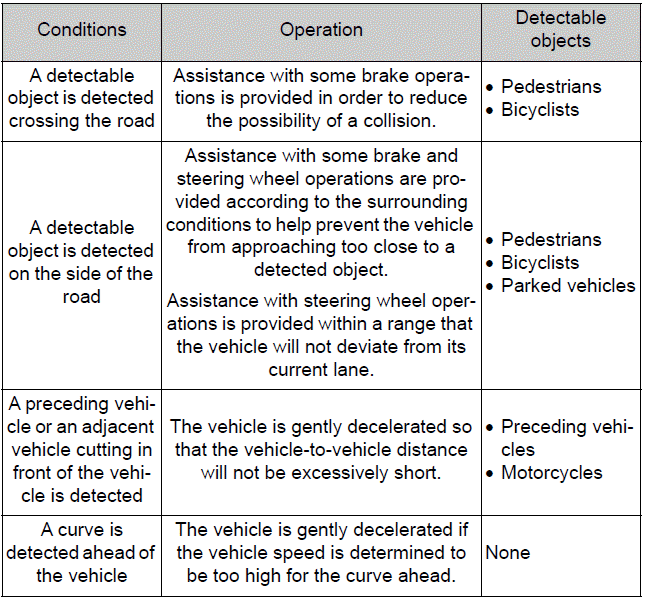
Conditions → Operation
→ Detectable
objects
A detectable
object is detected
crossing the road
→ Assistance with
some brake operations
is provided in order to reduce
the possibility of a collision. →
A detectable
object is detected
on the side of the
road
→ Assistance with some brake
and
steering wheel operations are provided
according to the surrounding
conditions to help prevent the vehicle
from approaching too close to a
detected object.
Assistance with steering wheel operations
is provided within a range that
the vehicle will not deviate from its
current lane. →
- Pedestrians
- Bicyclists
- Parked vehicles
A preceding vehicle
or an adjacent
vehicle cutting in
front of the vehicle
is detected
→ The vehicle is gently
decelerated so
that the vehicle-to-vehicle distance
will not be excessively short. →
- Preceding vehicles
- Motorcycles
A curve is
detected ahead of
the vehicle
→ The vehicle is gently
decelerated if
the vehicle speed is determined to
be too high for the curve ahead. → None
Vehicle speeds at which the system can operate
- Detectable object crossing the road assistance
The system is designed to operate optimally at speeds ranging from approximately 20 to 35 mph (30 to 60 km/h) when objects cross the roadway, ensuring precise intervention when needed.
- Detectable object on the side of the road assistance
Side object detection assistance is active within the same speed range of approximately 20 to 35 mph (30 to 60 km/h), which is ideal for handling urban traffic and suburban drive conditions.
- Preceding vehicle deceleration assistance
Deceleration support for the vehicle when a preceding vehicle is slowing down is engaged at speeds of approximately 15 mph (20 km/h) or above, promoting a smoother and safer reduction in speed.
- Curve deceleration assistance
For on-curve driving, deceleration assistance is activated at speeds of around 15 mph (20 km/h) or higher, contributing to enhanced control while navigating bends.
- Steering assist within a lane
Lane-keeping assistance is effective over a broad speed range, from approximately 5 to 80 mph (10 to 140 km/h), which allows for continuous support whether driving in congested areas or on open highways.
System operation will be canceled when
- In the following situations, system operation will be canceled:
- When dynamic radar cruise control or standard cruise control is active, to prevent conflicts between systems.
- When the Pre-Collision System (PCS) is switched off, as coordinated safety features are interdependent.
- If one or more functions of the system are unable to operate correctly.
- When the transmission is shifted into P, R, or N, where driving assistance is not required.
- In the following situations, the brake operation assist will be canceled:
- At very low speeds - roughly 9 mph (15 km/h) or less.
- When the system determines that a specific vehicle speed, based on the surrounding conditions, has been reached.
- In the following situations, overall system operation may be canceled:
- When another driving support system (e.g., PCS or drive-start control) restricts brake control or output.
- When a previously detected object moves away from the vehicle.
- When lane markings are no longer identifiable.
- When either the brake pedal or accelerator is pressed, indicating active driver control.
- When the steering wheel is turned with an excessive amount of force, implying manual override.
- When the turn signal lever is activated for a left or right turn.
WARNING
Situations in which the system may not operate properly
- When lane markings are worn out, unclear, or obscured by environmental conditions.
- When a detectable object halts abruptly just before entering the vehicle's path, leaving little time for response.
- When passing extremely close to a detectable object hidden behind a barrier like a guardrail or fence.
- When changing lanes while overtaking an object, due to the rapidity of the maneuver.
- When the detected object itself is in the process of changing lanes or turning.
- When there is a dense cluster of objects-such as guardrails, power poles, trees, walls, or traffic cones-that can confuse the sensors.
- When road patterns or decorative artwork are mistakenly detected as objects.
- When driving through areas with low overhead clearances like tunnels or zones with short signage.
- When the roadway is altered by snow, ice, or heavy rutting, which interferes with sensor accuracy.
- When a detectable object is rapidly approaching, thus limiting reaction time.
- When either the vehicle or the detectable object is moving erratically or unpredictably.
- When sudden changes in the detectable object's speed or direction occur.
- When you are unexpectedly nearing a detected object.
- When the object ahead, such as a preceding vehicle or motorcycle, is not directly in the vehicle’s path.
- When an overhead structure is present above the detectable object.
- When a portion of a detectable object is obscured by another item (e.g., large luggage or an umbrella).
- When multiple detectable objects overlap, making clear detection challenging.
- When bright light-from sunlight or headlights-reflects off an object, impairing sensor performance.
- When the detectable object is predominantly white and appears excessively bright.
- When the object’s color or brightness causes it to blend into its background.
- When a detectable object cuts in front of or emerges beside your vehicle unexpectedly.
- When approaching a vehicle that is perpendicular to or angled against your direction, or facing you directly.
- If a parked vehicle is positioned at an angle relative to your vehicle's course.
- When confronting a bicycle of unusual size, load, or shape (such as those with extra seating or tandem designs).
- When a pedestrian or bicyclist is significantly shorter than approximately 3.2 ft (1 m) or taller than roughly 6.5 ft (2 m), which can affect detection accuracy.
- When a pedestrian or bicyclist’s silhouette is hard to distinguish due to worn clothing or posture (e.g., wearing a raincoat or long skirt).
- When a pedestrian or bicyclist is bending forward or squatting.
- When a pedestrian or bicyclist moves at a high velocity, leaving minimal response time.
- When a pedestrian is pushing another object such as a stroller, wheelchair, or bicycle.
- When a detectable object merges with its surroundings under low light conditions (such as at dawn, dusk, or inside a tunnel).
- When the lane is either excessively wide-around 13.1 ft (4 m) or more-or very narrow-approximately 8.2 ft (2.5 m) or less-which can compromise system accuracy.
- When the vehicle has not been in motion for an extended period after the EV system has been activated, potentially affecting sensor calibration.
- During or just after turning left or right, when transient dynamics can interfere with sensor input.
- While actively changing lanes or immediately after a lane change, due to rapid vehicle dynamics.
- When entering, negotiating, or exiting a curve, during which vehicle stability is highly dynamic.
By integrating cutting-edge sensor technology and adaptive algorithms, this intelligent safety system continuously monitors real-time driving conditions and adjusts its responses to enhance road safety and driver awareness. Engineered to offer comprehensive support during challenging driving scenarios, it reinforces overall vehicle control and fosters a secure driving environment. For those seeking an advanced driver assistance system that embodies innovation and reliability, the exceptional features found in the Toyota bZ4X set a new standard in automotive safety.
Changing proactive driving
assist settings
- The proactive driving assist
can be enabled/disabled
through a customize setting.
- The settings of the proactive
driving assist can be changed
on the customize settings.
System operation display
Depending on the situation, the following indicators or icons will be
displayed.
Some icons cannot be displayed unless the display is changed to
the driving safety support function information screen.
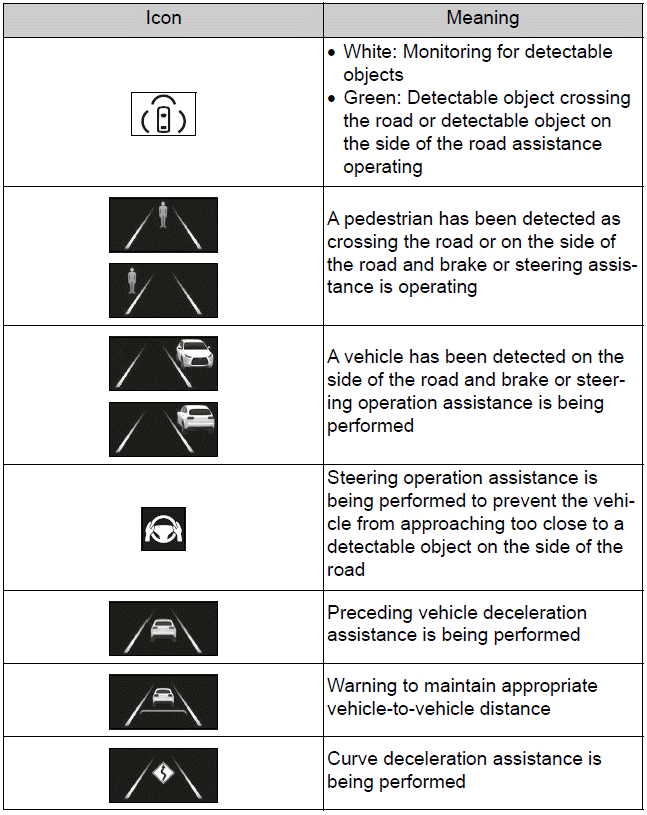
 White: Monitoring for
detectable
objects
White: Monitoring for
detectable
objects- Green: Detectable object crossing
the road or detectable object on
the side of the road assistance
operating
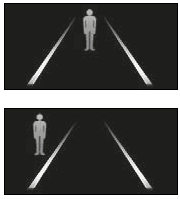 A pedestrian has been
detected as
crossing the road or on the side of
the road and brake or steering assistance
is operating
A pedestrian has been
detected as
crossing the road or on the side of
the road and brake or steering assistance
is operating
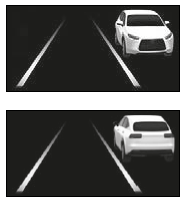 A vehicle has been detected on
the
side of the road and brake or steering
operation assistance is being
performed
A vehicle has been detected on
the
side of the road and brake or steering
operation assistance is being
performed
 Steering operation assistance
is
being performed to prevent the vehicle
from approaching too close to a
detectable object on the side of the
road
Steering operation assistance
is
being performed to prevent the vehicle
from approaching too close to a
detectable object on the side of the
road
 Preceding vehicle deceleration
assistance is being performed
Preceding vehicle deceleration
assistance is being performed
 Warning to maintain appropriate
vehicle-to-vehicle distance
Warning to maintain appropriate
vehicle-to-vehicle distance
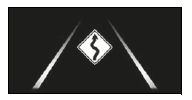 Curve deceleration assistance
is
being performed
Curve deceleration assistance
is
being performed
Basic Functions
The Lane Departure Alert (LDA) system is designed to help drivers maintain lane positioning by providing warnings when unintentional lane deviation is detected. Additionally, it can m ...
The RSA system identifies critical road signs by utilizing the front camera and, if available, the navigation system to access speed limit and other sign data. When such information is retrieved, the ...
Other articles:
Operating the lights and wipers
Headlight Switch
The headlights can be operated manually or automatically.
Turning on the Headlights
The headlight switch provides versatile control over your vehicle’s lighting system. In manual mode, you have full control to turn the headlights on or off at your discretion. Alternativ ...
Cleaning and Protecting the Vehicle Interior – Essential Maintenance Guide
Proper Interior Cleaning Techniques
Maintaining the interior of your vehicle ensures a comfortable driving environment and extends the lifespan of various materials. Each surface requires specific care to avoid unnecessary wear and damage.
General Cleaning Instructions
Use a vacuum cl ...


 White: Monitoring for
detectable
objects
White: Monitoring for
detectable
objects A pedestrian has been
detected as
crossing the road or on the side of
the road and brake or steering assistance
is operating
A pedestrian has been
detected as
crossing the road or on the side of
the road and brake or steering assistance
is operating A vehicle has been detected on
the
side of the road and brake or steering
operation assistance is being
performed
A vehicle has been detected on
the
side of the road and brake or steering
operation assistance is being
performed Steering operation assistance
is
being performed to prevent the vehicle
from approaching too close to a
detectable object on the side of the
road
Steering operation assistance
is
being performed to prevent the vehicle
from approaching too close to a
detectable object on the side of the
road Preceding vehicle deceleration
assistance is being performed
Preceding vehicle deceleration
assistance is being performed Warning to maintain appropriate
vehicle-to-vehicle distance
Warning to maintain appropriate
vehicle-to-vehicle distance Curve deceleration assistance
is
being performed
Curve deceleration assistance
is
being performed LDA (Lane Departure Alert)
LDA (Lane Departure Alert) RSA (Road Sign Assist)
RSA (Road Sign Assist)